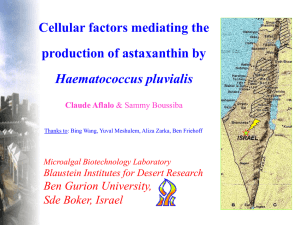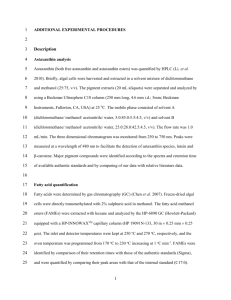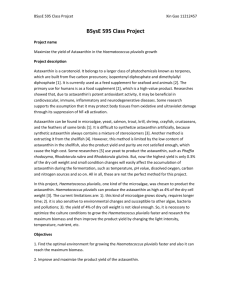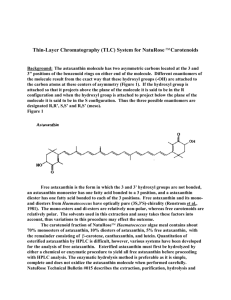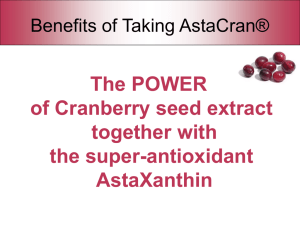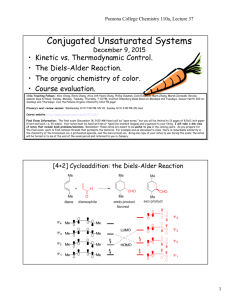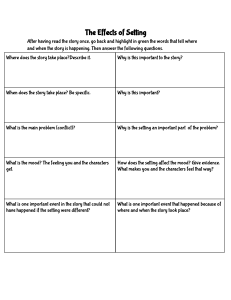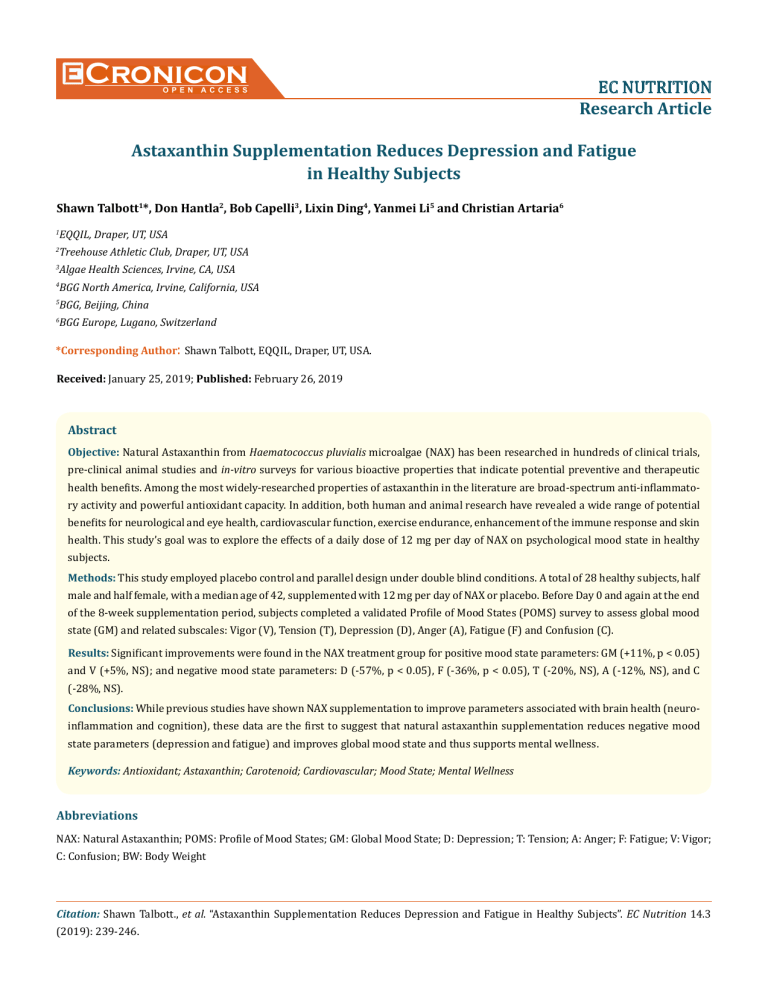
Cronicon O P EN A C C ESS EC NUTRITION Research Article Astaxanthin Supplementation Reduces Depression and Fatigue in Healthy Subjects Shawn Talbott1*, Don Hantla2, Bob Capelli3, Lixin Ding4, Yanmei Li5 and Christian Artaria6 1 EQQIL, Draper, UT, USA 2 Treehouse Athletic Club, Draper, UT, USA 3 Algae Health Sciences, Irvine, CA, USA 4 BGG North America, Irvine, California, USA 5 BGG, Beijing, China 6 BGG Europe, Lugano, Switzerland *Corresponding Author: Shawn Talbott, EQQIL, Draper, UT, USA. Received: January 25, 2019; Published: February 26, 2019 Abstract Objective: Natural Astaxanthin from Haematococcus pluvialis microalgae (NAX) has been researched in hundreds of clinical trials, pre-clinical animal studies and in-vitro surveys for various bioactive properties that indicate potential preventive and therapeutic health benefits. Among the most widely-researched properties of astaxanthin in the literature are broad-spectrum anti-inflammatory activity and powerful antioxidant capacity. In addition, both human and animal research have revealed a wide range of potential benefits for neurological and eye health, cardiovascular function, exercise endurance, enhancement of the immune response and skin health. This study’s goal was to explore the effects of a daily dose of 12 mg per day of NAX on psychological mood state in healthy subjects. Methods: This study employed placebo control and parallel design under double blind conditions. A total of 28 healthy subjects, half male and half female, with a median age of 42, supplemented with 12 mg per day of NAX or placebo. Before Day 0 and again at the end of the 8-week supplementation period, subjects completed a validated Profile of Mood States (POMS) survey to assess global mood state (GM) and related subscales: Vigor (V), Tension (T), Depression (D), Anger (A), Fatigue (F) and Confusion (C). Results: Significant improvements were found in the NAX treatment group for positive mood state parameters: GM (+11%, p < 0.05) and V (+5%, NS); and negative mood state parameters: D (-57%, p < 0.05), F (-36%, p < 0.05), T (-20%, NS), A (-12%, NS), and C (-28%, NS). Conclusions: While previous studies have shown NAX supplementation to improve parameters associated with brain health (neuro- inflammation and cognition), these data are the first to suggest that natural astaxanthin supplementation reduces negative mood state parameters (depression and fatigue) and improves global mood state and thus supports mental wellness. Keywords: Antioxidant; Astaxanthin; Carotenoid; Cardiovascular; Mood State; Mental Wellness Abbreviations NAX: Natural Astaxanthin; POMS: Profile of Mood States; GM: Global Mood State; D: Depression; T: Tension; A: Anger; F: Fatigue; V: Vigor; C: Confusion; BW: Body Weight Citation: Shawn Talbott., et al. “Astaxanthin Supplementation Reduces Depression and Fatigue in Healthy Subjects”. EC Nutrition 14.3 (2019): 239-246. Astaxanthin Supplementation Reduces Depression and Fatigue in Healthy Subjects 240 Introduction Natural astaxanthin (NAX) is a red carotenoid that provides characteristic color to pink flamingo feathers, red shrimp shells, and pink salmon flesh. The high level of NAX in these tissues is reflective of the animal’s dietary intake of NAX from microalgae, copepods, krill, and other lower food chain organisms [1,2]. Astaxanthin is found in the human food chain in red-hued sea animals including crab, shrimp and lobster (in low quantities) and in the highest quantity in wild salmon [3-5]. NAX exists as one stereoisomeric form (3S,3’S) [2]. Other ste- reoisomeric forms of astaxanthin exist in yeast and bacteria as well as in astaxanthin produced synthetically from petrochemicals (SAX). The other forms found in these alternative sources are (3R,3’R), and (3R,3’S) (meso). Astaxanthin synthesized from petrochemicals is widely used in farmed fish such as salmon and trout. Synthetically produced astaxanthin contains all three stereoisomeric forms while wild salmon contains exclusively 3S,3’S [6]. NAX is found in nature in the highest concentration in Haematococcus pluvialis microalgae which is the source of the vast majority of astaxanthin consumed in supplement and functional food forms. NAX is widely accepted by regulatory bodies around the world as a human nutritional supplement and in functional foods. Other forms including SAX and forms from yeast and bacteria are generally not accepted by regulators or are accepted with restrictions due to lack of safety data and clinical research in humans. NAX contains small amounts of related carotenoids naturally occurring in the microalgae and is primarily esterified with fatty acid molecules attached at the end of the astaxanthin molecule. 3S,3’S stereoisomers comprise approximately 96% of the carotenoid fraction. The additional carotenoids found in NAX include zeaxanthin, lutein, canthaxanthin and beta-carotene. These chemical differences between forms of astaxanthin and the co-existence of other natural carotenoids may result in increased bioavailability and synergistic benefits for NAX as compared to SAX [7,8]. NAX has been studied for its antioxidant, anti-inflammatory, eye health benefits, cardioprotective properties, immune system modula- tory activity and neuroprotective activities in humans [9-13]. Studies in rats and mice have indicated that NAX may reduce hypertension and increase blood flow [14,15]. The mechanisms proffered in this research were a modulatory effect on cellular stress pathways such as nitric oxide, nuclear factor E2 related factor 2 (Nrf2) and nuclear factor kB (NFkB) [16]. Astaxanthin has demonstrated wide-ranging benefits for athletes including improving endurance and performance, decreasing lac- tic acid levels after exercise and increasing fat oxidation/metabolism [17-27]. Dietary AX accumulates in muscle tissue in mammals. In muscles heavily worked during prolonged exercise, it prevents peroxidation of DNA and lipids and reduces muscle damage [17-19]. Furthermore, during exercise, AX may ameliorate fat oxidation. Mice supplemented with AX at 6 - 30 mg/kg BW over 4 - 5 weeks demonstrated increased fat utilization and longer treadmill running time/swimming time before exhaustion [19,20]. The mechanism for these effects was postulated as improvement in mitochondrial capacity of fatty acyl-CoA uptake through improvement of the function of carnitine palmitoyltransferase 1 (CPT1), which occurs due to astaxanthin’s protective effect of the mitochondrial membrane from oxida- tive damage. Earlier research on NAX’s effects in animal models demonstrated attenuation of exercise-induced damage to cardiac and skeletal muscle, along with improvement in fat oxidation, redox balance and time to exhaustion during exercise [17-22]. Several rodent studies supplemented NAX at 6 - 30 mg/kg which would translate to high dosages in humans [18-21]. Another rodent study employed a significantly lower dosage of 1 mg/kg and still found increased time to physical exhaustion and improvement in redox balance [23]. (Human trials have found positive results for a variety of health benefits at much lower dosages per kg BW than the rodent studies in the literature. The normal range in human clinical research has been 2 mg to 20 mg per day regardless of BW.) Many of astaxanthin’s effects may be attributable to a hypothesized mitochondrial-centric mechanism, which could improve energy and redox cellular metabolism (e.g. via Nrf2-ARE pathway activation). Indeed, mitochondrial redox metabolism has been implicated in various neurological disorders includ- ing Alzheimer’s, Parkinson’s, and age-related dementia, so it is logical that NAX has been suggested to play a putative prophylactic role in cardiovascular as well as neurologic conditions [28-39]. Citation: Shawn Talbott., et al. “Astaxanthin Supplementation Reduces Depression and Fatigue in Healthy Subjects”. EC Nutrition 14.3 (2019): 239-246. Astaxanthin Supplementation Reduces Depression and Fatigue in Healthy Subjects 241 Antioxidant status showed consistent improvement in human research on obese subjects leading a sedentary lifestyle [25,26] as well as in untrained men [27]. Athletes supplementing with NAX for 4 weeks experienced reduced lactic acid levels after running 1200 me- ters [22]. In a study on competitive cyclists, significant improvements in power output (15%) and improvement in cycling time trial (5% reduction over 20 km for an average 2 minute mean decrease) was found at a relatively low dosage of 4 mg per day over 4 weeks [24]. Material and Methods Participants Twenty-eight healthy, active, non-depressed adult subjects (14 men and 14 women) were supplemented with NAX for 8-weeks (age 42 ± 8, range 26 - 63 years; height 169 ± 10 cm; BW 69 ± 6 kg). An external ethics board reviewed informed consent forms which all subjects completed prior to commencement of the study. Astaxanthin source Using a double-blind method, the subjects were randomly separated into two pools. The treatment group received a NAX supplement (AstaZine® Natural Astaxanthin, BGG/AlgaeHealth Sciences) while the control group received identically-matching placebo (PL). The NAX supplement contained an extract of Haematococcus pluvialis containing 12 mg of astaxanthin which was combined with medium chain triglyceride oil and a small amount of d-alpha tocopherol (10 IU) to maintain stability of the capsule formulation. Supplementation of NAX or PL continued by all subjects each day for the duration of the 8-week study period. No adverse events related to ingestion of NAX or PL were reported. Mood state assessment Before and after the supplementation period, subjects completed a validated psychological mood state survey (POMS, Profile of Mood States) to assess Global Mood State and 6 related subscales; Vigor (V), Tension (T), Depression (D), Anger (A), Fatigue (F), and Confusion (C). The POMS survey is a self-administered 64-question assessment that takes approximately 20 minutes to complete and was collected before and after the 8-week supplementation period. Data management and analysis A database was employed in a central location to maintain participant data. Subject numbers were used to identify the data, with thor- ough examination for completeness and accuracy. JMP 8.0 (SAS Institute, Cary, NC) using standard parametric paired t tests was employed to analyze the tabulated data, with a 2-tailed alpha level set at 0.05 used to assess significance. Results Baseline characteristics for participants are presented in table 1. Significant improvements were found in NAX for positive mood state parameters (Figures 1 and 2): Global Mood (+11%, p < 0.05) and Vigor (+5%, NS); and negative mood state parameters: Depression (-57%, p < 0.05), Fatigue (-36%, p < 0.05), Confusion (-28%, NS), Tension (-20%, NS), and Anger (-12%, NS) indicating a beneficial psychological effect of NAX on overall mood and specifically in reducing depression and fatigue. Height (cm) Weight (kg) Body Fat (%) NAX PL 169 (11) 168 (9) 70.0 (7.1) 20.3 (6.3) 69.3 (7.0) 24.9 (8.4) Table 1: Baseline subject characteristics. Data represent average (Mean) values (±SD). Abbreviations: NAX: Natural Astaxanthin Group; PL: Placebo Group. Citation: Shawn Talbott., et al. “Astaxanthin Supplementation Reduces Depression and Fatigue in Healthy Subjects”. EC Nutrition 14.3 (2019): 239-246. Astaxanthin Supplementation Reduces Depression and Fatigue in Healthy Subjects 242 Figure 1: Psychological Global Mood State at Baseline (pre-supplementation) and week 8 (post-supplementation). Improvements were found in NAX for Global Mood (-11%, NAX = 127+20 v. PL = 127+20; p < 0.05)* *Global Mood State = a lower score indicates a more positive psychological mood state. Abbreviations: NAX: Natural Astaxanthin Group; PL: Placebo Group. Figure 2: Psychological Mood State Sub-Scales at Baseline (pre-supplementation) and week 8 (post-supplementation). Improvements were found in NAX for some mood state subscales: Tension (-20%, NS), *Depression (-57%, p < 0.05), Anger (-12%, NS), Vigor (+5%, NS), *Fatigue (-36%, p < 0.05), and Confusion (-28%, NS). Abbreviations: NAX: Natural Astaxanthin Group; PL: Placebo Group. Citation: Shawn Talbott., et al. “Astaxanthin Supplementation Reduces Depression and Fatigue in Healthy Subjects”. EC Nutrition 14.3 (2019): 239-246. Astaxanthin Supplementation Reduces Depression and Fatigue in Healthy Subjects 243 Discussion Jiang., et al. [28] recently demonstrated potential psychological effects of NAX, subsequent to serotonergic and anti-inflammatory effects, in an animal model of stress-induced depression. Other animal models suggest that NAX may be advantageous in neuroprotection due to its ability to locate inside the phospholipid membrane and at the membrane surface, as well as its facility in crossing the blood-brain barrier [28-31] leading to a wide range of potential psychological benefits including enhanced cognitive function [32,36,38], reduced depression [32], lower anxiety [34,35] and neuroprotection [38,39]. The heart is recognized to play a vital role not only as a circulatory pump, but as part of a psychophysiological network as a generator and transmitter of system-wide information throughout multiple body systems, including the nervous system [40-45]. Electrical input from the heart can dynamically influence homeostatic, cognitive, perceptual, and emotional processing in the brain, thus having the potential to affect myriad aspects of mood and behavior [40-43]. Thayer and Lane [40] reviewed the direct and indirect connections between the heart and the brain, including the physiological, behavioral, emotional, and cognitive processes involved in bi-directional control of cortical/cardiac function. Organ crosstalk between the brain/heart has been noted in stress-related cardiomyopathy syndromes and traumatic brain injury [41] including the use of heart rate variability (HRV) for its importance in gauging both the state of the heart (physical stress) as well as the state of the brain (psychological stress). Yoga, as an intervention to restore balance heart-brain crosstalk through plasticity and stability of the autonomic nervous system, has been used to reduce anxiety levels, atrial fibrillation episodes, blood pressure and neurocardiogenic syncope [42]. Studies have also shown that positive emotional states may improve function of both the cardiovascular and immune systems [44,45]. Human clinical research on astaxanthin’s effects on brain health have shown some promising potential health benefits. In a trial on elderly subjects with age-related forgetfulness, improvement in age-related decline in cognitive and psychomotor function was found in the treatment group when supplementing with 12 mg per day of NAX over 12 weeks [46]. A subsequent study measured a marker for dementia, phospholipid hydroperoxides, which accumulate in the erythrocytes of dementia patients. The researchers tested 6mg of NAX and 12 mg of NAX against placebo over 12 weeks. At both dosages, NAX significantly reduced the levels of this dementia marker [47]. Lastly, a study testing for cognitive function of healthy elderly subjects who complained of age-related forgetfulness was done over 12 weeks. The subject pool was 96 people randomly assigned to take 6 mg of NAX, 12 mg of NAX or placebo. A variety of tests were done on these subjects including blood work, urine screens and assessments on two different cognitive tests called the Groton Maze Learning Test and CogHealth. Results in both the 6 mg and 12 mg treatment groups were significant, with slightly better results in the 12 mg group. The researchers concluded that NAX improves cognitive function in healthy aged subjects [48]. The current study found intriguing psychological mood state benefits of NAX supplementation. The results were in a different area of mental health as compared to the three clinical trials cited immediately above, which examined potential benefits for the brains of an ag- ing population. The results in this present study may apply to a general population regardless of age. They indicate that people may feel better mentally by supplementing with NAX. Results leading to this hypothesis include a significantly higher overall mood (Global Mood State +11%, p < 0.05) and a significant reduction in Depression (-57%, p < 0.05) and Fatigue (-36, p < 0.05). This was the first study to demonstrate these results in a population of healthy human volunteers. Conclusions While previous studies have shown NAX supplementation to improve parameters associated with brain health (neuro-inflammation and cognition), these data are the first to suggest that natural astaxanthin supplementation reduces negative mood state parameters (depression and fatigue) and improves global mood state and thus supports mental wellness. Citation: Shawn Talbott., et al. “Astaxanthin Supplementation Reduces Depression and Fatigue in Healthy Subjects”. EC Nutrition 14.3 (2019): 239-246. Astaxanthin Supplementation Reduces Depression and Fatigue in Healthy Subjects 244 Acknowledgments Funding and astaxanthin supplements for this study were provided by Algae Health Sciences, a division of BGG. Disclosure This work was funded by Algae Health Sciences, a division of BGG. Talbott was principal investigator and reports no conflicts of interest in this work. Hantla reports no conflict of interest. Capelli is an employee of Algae Health Sciences, and Li, Ding and Artaria are employees of BGG, BGG North America and BGG Europe, which are companies involved in the production and distribution of NAX. Bibliography 1. 2. 3. 4. 5. 6. 7. 8. 9. Fassett RG and Coombes JS. “Astaxanthin in cardiovascular health and disease”. Molecules 17.2 (2012): 2030-2048. Ambati RR., et al. “Astaxanthin: sources, extraction, stability, biological activities and its commercial applications--a review”. Marine Drugs 12.1 (2014): 128-152. Guerin M., et al. “Haematococcus astaxanthin: applications for human health and nutrition”. Trends in Biotechnology 21.5 (2003): 210-216. Higuera-Ciapara I., et al. “Astaxanthin: a review of its chemistry and applications”. Critical Reviews in Food Science and Nutrition 46.2 (2006): 185-196. Hussein G., et al. “Astaxanthin, a carotenoid with potential in human health and nutrition”. Journal of Natural Products 69.3 (2006): 443-449. Megdal PA., et al. “A simplified method to distinguish farmed (Salmo salar) from wild salmon: fatty acid ratios versus astaxanthin chiral isomers”. Lipids 44.6 (2009): 569-576. Shah MMR., et al. “Astaxanthin-Producing Green Microalga Haematococcus pluvialis: From Single Cell to High Value Commercial Products”. Frontiers in Plant Science 7 (2016): 531. Okada Y., et al. “Bioavailability of astaxanthin in Haematococcus algal extract: the effects of timing of diet and smoking habits”. Bioscience, Biotechnology, and Biochemistry 73.9 (2009): 1928-1932. Rüfer CE., et al. “Bioavailability of astaxanthin stereoisomers from wild (Oncorhynchus spp.) and aquacultured (Salmo salar) salmon in healthy men: a randomised, double-blind study”. British Journal of Nutrition 99.5 (2008): 1048-1054. 10. Naguib YM. “Antioxidant activities of astaxanthin and related carotenoids”. Journal of Agricultural and Food Chemistry 48.4 (2000): 1150-1154. 11. Ohgami K., et al. “Effects of astaxanthin on lipopolysaccharide-induced inflammation in vitro and in vivo”. Investigative Ophthalmology and Visual Science 44.6 (2003): 2694-2701. 12. Pashkow FJ., et al. “Astaxanthin: a novel potential treatment for oxidative stress and inflammation in cardiovascular disease”. American Journal of Cardiology 101.10A (2008): 58D-68D. 13. Park JS., et al. “Astaxanthin decreased oxidative stress and inflammation and enhanced immune response in humans”. Nutrition and Metabolism 7 (2010): 18. 14. Spiller GA and Dewell A. “Safety of an astaxanthin-rich Haematococcus pluvialis algal extract: a randomized clinical trial”. Journal of Medicinal Food 6.1 (2003): 51-56. Citation: Shawn Talbott., et al. “Astaxanthin Supplementation Reduces Depression and Fatigue in Healthy Subjects”. EC Nutrition 14.3 (2019): 239-246. Astaxanthin Supplementation Reduces Depression and Fatigue in Healthy Subjects 245 15. Hussein G., et al. “Antihypertensive potential and mechanism of action of astaxanthin: II. Vascular reactivity and hemorheology in spontaneously hypertensive rats”. Journal of Medicinal Food 28.6 (2005): 967-971. 16. Hussein G., et al. “Antihypertensive potential and mechanism of action of astaxanthin: III. Antioxidant and histopathological effects in spontaneously hypertensive rats”. Biological and Pharmaceutical Bulletin 29.4 (2006): 684-688. 17. Farruggia C., et al. “Astaxanthin plays anti-inflammatory and antioxidant effects by inhibiting NFkB nuclear translocation and NOX2 expression in macrophages”. FASEB Journal 29.1 (2015): 603. 18. Aoi W., et al. “Astaxanthin limits exercise-induced skeletal and cardiac muscle damage in mice”. Antioxidants and Redox Signaling 5.1 (2003): 139-144. 19. Aoi W., et al. “Astaxanthin improves muscle lipid metabolism in exercise via inhibitory effect of oxidative CPT I modification”. Biochemical and Biophysical Research Communications 366.4 (2008): 892-897. 20. Ikeuchi M., et al. “Effects of astaxanthin supplementation on exercise-induced fatigue in mice”. Biological and Pharmaceutical Bulletin 29.10 (2006): 2106-2110. 21. Ikeuchi M., et al. “Effects of astaxanthin in obese mice fed a high-fat diet”. Bioscience, Biotechnology, and Biochemistry 71.4 (2007): 893-899. 22. Keisuke S., et al. “Sports Performance Benefits from Taking Natural Astaxanthin Characterized by Visual Acuity and Muscle Fatigue Improvement in Humans”. Journal of Clinical Medicine and Therapeutics 18 (2002): 1085-1100. 23. Polotow TG., et al. “Astaxanthin supplementation delays physical exhaustion and prevents redox imbalances in plasma and soleus muscles of Wistar rats”. Nutrients 6.12 (2014): 5819-5838. 24. Earnest CP., et al. “Effect of astaxanthin on cycling time trial performance”. International Journal of Sports Medicine 32.11 (2011): 882-888. 25. Choi HD., et al. “Effects of astaxanthin on oxidative stress in overweight and obese adults”. Phytotherapy Research 25.12 (2011): 1813-1818. 26. Choi HD., et al. “Positive effects of astaxanthin on lipid profiles and oxidative stress in overweight subjects”. Plant Foods for Human Nutrition 66.4 (2011): 363-369. 27. Karppi J., et al. “Effects of astaxanthin supplementation on lipid peroxidation”. International Journal for Vitamin and Nutrition Research 77.1 (2007): 3-11. 28. Jiang X., et al. “The antidepressant-like effect of trans-astaxanthin involves the serotonergic system”. Oncotarget 8.15 (2017): 2555225563. 29. Zhou XY., et al. “Depression can be prevented by astaxanthin through inhibition of hippocampal inflammation in diabetic mice”. Brain Research 1657 (2017): 262-268. 30. Jiang X., et al. “Trans-astaxanthin attenuates lipopolysaccharide-induced neuroinflammation and depressive-like behavior in mice”. Brain Research 1649 (2016): 30-37. 31. Al-Amin MM., et al. “Astaxanthin ameliorates prenatal LPS-exposed behavioral deficits and oxidative stress in adult offspring”. BMC Neuroscience 17 (2016): 11. Citation: Shawn Talbott., et al. “Astaxanthin Supplementation Reduces Depression and Fatigue in Healthy Subjects”. EC Nutrition 14.3 (2019): 239-246. Astaxanthin Supplementation Reduces Depression and Fatigue in Healthy Subjects 246 32. Wibrand K., et al. “Enhanced cognitive function and antidepressant-like effects after krill oil supplementation in rats”. Lipids in Health and Disease 12 (2013): 6. 33. Abadie-Guedes R., et al. “The impairing effect of acute ethanol on spreading depression is antagonized by astaxanthin in rats of 2 young-adult ages”. Alcoholism: Clinical and Experimental Research 36.9 (2012): 1563-1567. 34. Mattei R., et al. “Astaxanthin limits fish oil-related oxidative insult in the anterior forebrain of Wistar rats: putative anxiolytic effects?” Pharmacology Biochemistry and Behavior 99.3 (2011): 349-355. 35. Nishioka Y., et al. “The antianxiety-like effect of astaxanthin extracted from Paracoccus carotinifaciens”. Biofactors 37.1 (2011): 25-30. 36. Liu X and Osawa T. “Astaxanthin protects neuronal cells against oxidative damage and is a potent candidate for brain food”. Forum of Nutrition 61 (2009): 129-135. 37. Curek., et al. “Effect of astaxanthin on hepatocellular injury following ischemia/reperfusion”. Toxicology 267.1-3 (2010): 147-153. 38. Barros MP., et al. “Neuroprotective properties of the marine carotenoid astaxanthin and omega-3 fatty acids, and perspectives for the natural combination of both in krill oil”. Nutrients 6.3 (2014): 1293-317. 39. Dhillon VS and Fenech M. “Mutations that affect mitochondrial functions and their association with neurodegenerative diseases”. Mutation Research/Reviews in Mutation Research 759 (2014): 1-13. 40. Thayer JF and Lane RD. “Claude Bernard and the heart-brain connection: further elaboration of a model of neurovisceral integration”. Neuroscience and Biobehavioral Reviews 33.2 (2009): 81-88. 41. Mazzeo AT., et al. “Brain-heart crosstalk: the many faces of stress-related cardiomyopathy syndromes in anaesthesia and intensive care”. British Journal of Anaesthesia 112.5 (2014): 803-815. 42. Gunda S., et al. “Role of yoga as an adjunctive therapy in patients with neurocardiogenic syncope: a pilot study”. Journal of Interventional Cardiac Electrophysiology 43.2 (2015): 105-110. 43. Shaffer F., et al. “A healthy heart is not a metronome: an integrative review of the heart’s anatomy and heart rate variability”. Frontiers in Psychology 5 (2014): 1040. 44. McCraty R., et al. “Impact of a workplace stress reduction program on blood pressure and emotional health in hypertensive employees”. Journal of Alternative and Complementary Medicine 9.3 (2003): 355-369. 45. McCraty R., et al. “The effects of emotions on short-term power spectrum analysis of heart rate variability”. American Journal of Cardiology 76.15 (1995): 1089-1093. 46. Satoh A., et al. “Preliminary clinical evaluation of toxicity and efficacy of a new Astaxanthin-rich Haematococcus pluvialis extract”. Journal of Clinical Biochemistry and Nutrition 44.3 (2009): 280-284. 47. Nakagawa K., et al. “Antioxidant effect of astaxanthin on phospholipid peroxidation in human erythrocytes”. British Journal of Nutrition 105.11 (2011): 1563-1571. 48. Katgiri M., et al. “Effects of astaxanthin-rich Haematococcus pluvialis extract on cognitive function: a randomized, double-blind, placebo-controlled study”. Journal of Clinical Biochemistry and Nutrition 51.2 (2012): 102-107. Volume 14 Issue 3 March 2019 ©All rights reserved by Shawn Talbott., et al. Citation: Shawn Talbott., et al. “Astaxanthin Supplementation Reduces Depression and Fatigue in Healthy Subjects”. EC Nutrition 14.3 (2019): 239-246.
